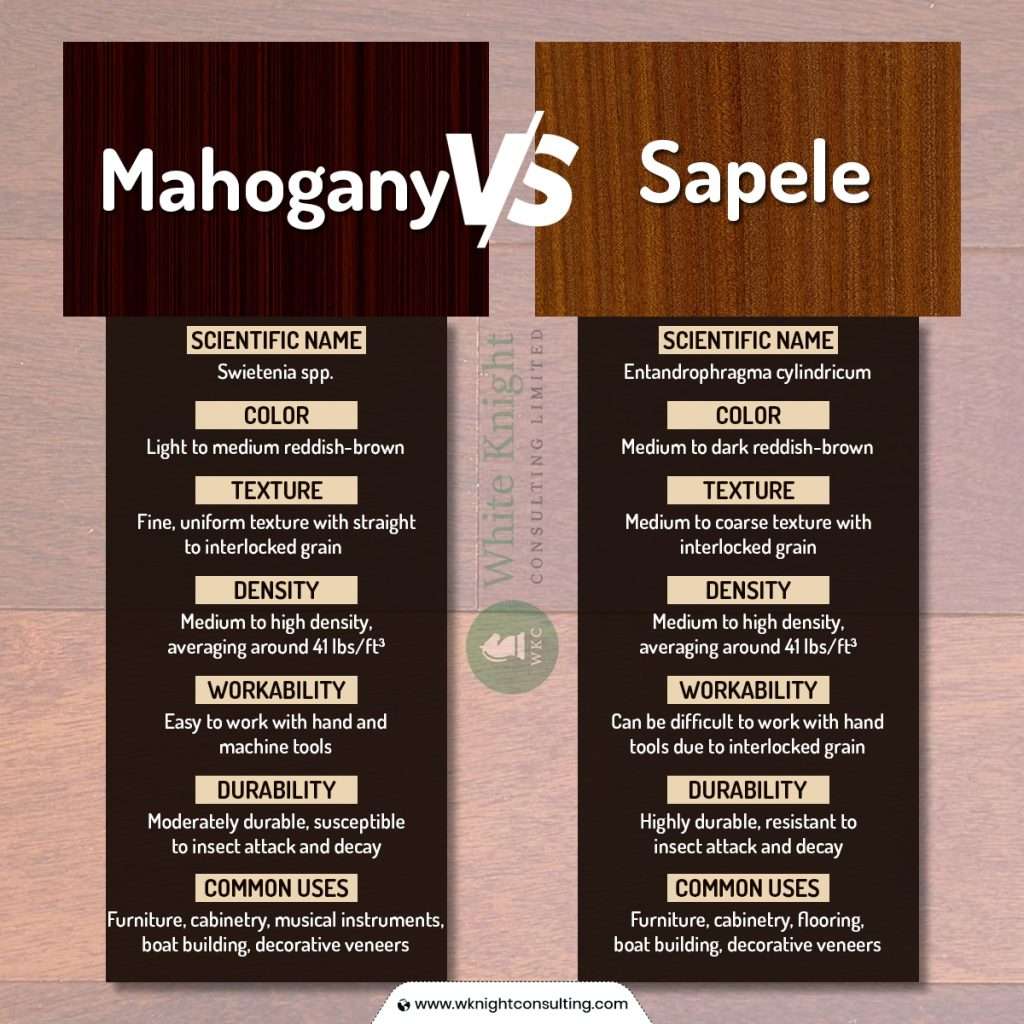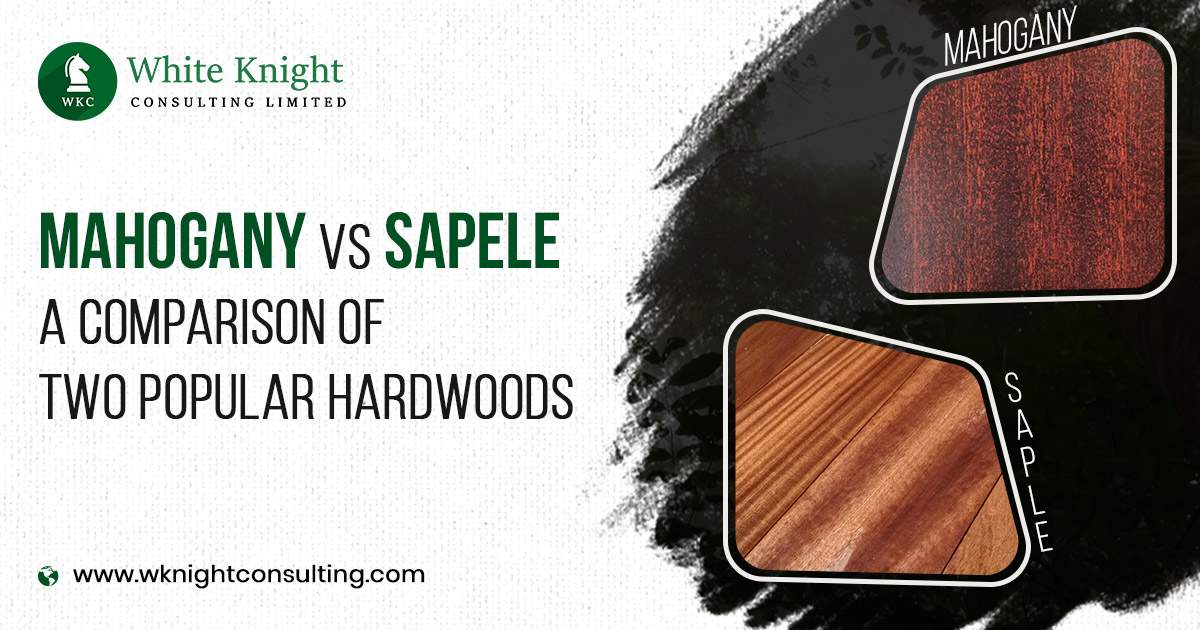While Mahogany is more famous for its unique rich appearance and strength, Sapele is preferred for its incredible hardness and durability. Both Mahogany and Sapele are wonderful choices for hardwood furniture, construction and many other applications.
If you are wondering about which wood is better between Mahogany vs Sapele, here’s a detailed overview of the two most popular hardwoods along with various similarities and differences between the two.
Sapele and Mahogany share many similarities, which is why the two are often used interchangeably in many projects. This is also why woodworkers can easily get confused between the two options. Here’s everything you need to know about the difference between Mahogany and Sapele.
About Mahogany Wood
Mahogany is a hardwood that is native to tropical regions of Central and South America, Africa, and the Caribbean. There are many species of Mahogany, of which Cuban, Honduran, and African mahogany are the most famous.
Mahogany species belong to the Swietenia genus. The wood is known for its unique rich reddish-brown colour and durability. It has been a popular choice for making premium furniture and decorative items for centuries. Today, mahogany is most commonly used for furniture, musical instruments, flooring, interior trim work, boatbuilding, and cabinetry.
About Sapele Wood
Sapele is a hardwood that is found in tropical African regions. It is also reddish-brown, the same as mahogany, but darker and with a more prominent grain pattern. Sapele is famous for its special figured grain patterns, which include quilted, pommele, wavy, fiddleback, and mottled.
Sapele is a durable and strong wood and very hard, which makes it suitable for use in high-traffic flooring, heavy-duty furniture and similar applications. It is often finished or stained to fit different styling needs. Sapele is frequently used as a low-cost alternative to mahogany. It is also commonly used for veneering and cabinetry.
Mahogany & Sapele: Similarities
Mahogany and Sapele share many similarities in terms of appearance, durability, workability and other properties.
Both species of wood are reddish-brown and have figured patterns or stripes. Both are considered durable and strong. Both mahogany and Sapele are easy to work with. As durable woods, they do not shrink or swell too much with changes in weather. Both are resistant to decay and suitable for outdoor use.
Mahogany Vs Sapele : Which is better?

Though mahogany and Sapele are practically similar in terms of appearance and various properties, there are also many differences between the two. The major difference is in terms of availability and cost. Sapele is readily available and costs less compared to mahogany, which may not be as easily available due to high demand.
Mahogany Vs Sapele
Technical Specifications:
| Technical Specifications | Mahogany | Sapele |
|---|---|---|
| Average Dried Weight (kg/m3) | 610 | 640 |
| Specific Gravity | 0.61 | 0.64 |
| Janka Hardness (N) | 4,180 | 1,410 |
| Modulus of Rupture (MPa) | 107 | 97 |
| Elastic Modulus (GPa) | 12 | 12 |
| Crushing Strength (MPa) | 65 | 67 |
| Shrinkage (%) | Radial: 5.8 Tangential: 9.4 Volumetric: 15.3 | Radial: 4.7 Tangential: 7.2 Volumetric: 12.4 |
Appearance
Colour: Mahogany has a more rich reddish-brown colour that looks great in its natural appearance and doesn’t usually need staining or colouring. The colour of mahogany gets darker with age. Mahogany is also famous for its rare optical phenomenon known as chatoyancy, where the surface of the timber gives off a 3D illusion when viewed at a certain angle.
On the other hand Sapele heartwood is also reddish-brown but the colour is darker and somewhat dull, which is made brighter using stains or oiling. The wood colour becomes darker with age.
Grain & Texture: Mahogany has a straight or interlocked or wavy grain and a medium and uniform texture, Whereas the grain pattern in Sapele is more prominent and clearly visible. In fact, Sapele is famous for its special figured grain patterns, which include ribbon, quilted, pommele, wavy, fiddleback, beeswing, mottled and others. Sapele usually has an interlocked or wavy grain pattern and a fine, uniform texture.
Physical Properties
Origin & Trees
Different species of mahogany are found in different regions of America. The species is grown both in tropical forests and man-made plantations. Sapele is almost exclusively found in the tropical forests of Africa.
Mahogany trees are about 150-200 ft (46-60 m) tall and have a 3-6 ft (1-2 m) trunk diameter. Sapele trees grow to a max height of up to 150 ft (45 m) and have an average 3-5 ft (1-1.5 m) trunk diameter.
Mahogany has a slower growth rate than Sapele. Due to high demand and over-exploitation, the species is regarded as endangered in some regions. Sustainable mahogany may not be as easily available. Sapele is a more readily and widely available sustainable hardwood option because of its fast growth rate and wider availability.
Hardness
Sapele is much harder than mahogany. The Janka rating of Sapele is 1,410 lbf as against the Janka score of Mahogany (Honduran), which is only 900 lbf.
Due to the higher Janka rating of Sapele, it is considered more resistant to wear and tear and considered more suitable than mahogany for flooring in high-traffic areas.
Weight & Density
Sapele is denser and weighs more than mahogany. The average dried weight of Sapele is around 670 kg/m3, while that of mahogany is 590 kg/m3.
Durability
Sapele is a durable wood, but it is less durable than mahogany. It can be moderately or extremely resistant to decay and provides good protection from insects and wood borers.
Mahogany is very durable, though the durability depends on the age and growing conditions of the tree. Lumber obtained from old, forest-grown mahogany trees is heavy and more durable than plantation timber. It is also resistant to termites but can be prone to other insects.
Stability
Both mahogany and Sapele are stable woods.
Mahogany is considered very stable, as it doesn’t shrink or swell a lot in response to changes in temperature and weather conditions. Sapele is also very stable but less so than mahogany, as it is somewhat prone to movement due to changes in weather and temperature. At the same time, Sapele will not easily warp or twist due to its outstanding dimensional stability.
Workability, Availability & Price
Workability
Both mahogany and Sapele are easy to work with.
Higher density and interlocked grain of Sapele can sometimes cause problems when working with machines. Planing and routing using machines can often result in tearout and there is a blunting effect on cutters. Sapele is also known to lose its colour or become stained when in direct contact with iron. It turns, glues, and finishes easily.
Mahogany, on the other hand, is much easier to work with both hand tools and machines. Timber with irregular or figured grain can sometimes cause problems such as tearout during machining. It is easy to sand, glue, stain, and finish.
Availability & Price
Cuban mahogany is the most popular, rare and very expensive. Honduran mahogany is also not easily available in many locations. It can be moderately expensive to very expensive depending on availability. Figured lumber is extremely rare and expensive.
Because Sapele is much more easily and widely available than mahogany, it is also less expensive. Regular lumber is moderately priced, however, figured or patterned timber can be much more expensive due to rare availability.
Uses
Sapele Uses
Common uses of Sapele wood include musical instruments, decorative veneer, furniture, flooring, boatbuilding, plywood, turned objects, cabinetry, panelling, exterior trim, siding, and other small wooden speciality items. It is also commonly used as a substitute for mahogany due to its lower price and easier availability. Sapele furniture, cabinets, tables, etc. are quite strong and durable. It is also used for making doors and windows. Sapele is one of the best woods for flooring, as it is durable and doesn’t scratch easily.
Mahogany Uses
Mahogany is mainly used for making fine furniture. Mahogany furniture is of high quality and durable and will easily last many decades with little maintenance. It is also commonly used for interior trim applications such as doors, window frames, and decorative parts of a building. Mahogany is a preferred wood for making high-end musical instruments like guitars, pianos, and violins. Water-resistant mahogany is also used for boat building and other exterior applications. Other uses of mahogany timber include cabinetry, veneer, flooring, panelling, turning (turned objects), and carving.
Mahogany vs Sapele: Which Wood Is Right for Your Project?
Due to the many similarities between mahogany and Sapele, they are often used interchangeably. Mahogany is not easily available and can be expensive, which is why many woodworkers opt for Sapele lumber as the closest alternative. Mahogany looks better due to its richer tone and warm hue and is perfect for decorative and fine wood applications. Sapele is more dimensionally stable and more durable, which makes it better for use in exterior trim and boat building. Mahogany is relatively easier to work with than Sapele.
Ultimately, the choice between mahogany and Sapele will depend on the particular project. Contact us to consult with a woodworking expert now.
Where to Buy Top-Quality Sapele and Mahogany Online?
If you are looking for the best retailer or wholesaler of Sapele and mahogany timber in your local area, you can search Google to find top timber suppliers in your city. If you are looking online, White Knight Consulting Ltd is your one-stop destination to buy top-quality sustainable Sapele and mahogany timber at the best price online with worldwide delivery.
White Knight Consulting Ltd is a UK-based supplier and exporter of timber in 20+ countries, including Canada, Africa, Australia, Vietnam, UAE, and many other European, African and Asian regions. Contact us to enquire about availability and price.
